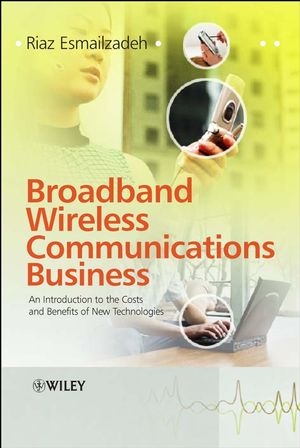
Broadband Wireless Communications Business
John Wiley & Sons Inc (Verlag)
978-0-470-01311-3 (ISBN)
- Titel z.Zt. nicht lieferbar
- Versandkostenfrei innerhalb Deutschlands
- Auch auf Rechnung
- Verfügbarkeit in der Filiale vor Ort prüfen
- Artikel merken
With the emergence of broadband wireless communication systems, new business opportunities have appeared for operators, content provides, and manufacturers. Broadband wireless communications technologies promise the freedom of constant access to the Internet at high speeds, without the limitation of connection cables. Broadband Wireless Communications Business provides comprehensive coverage of the present status and future evolution of these technologies, giving vital practical cost and benefit advice on design, construction and implementation. The author focuses on the costs associated with network design and operation, examining resources, maintenance and billing considerations in terms of Quality of Service provisioning. The future of 4G is explained, with enhancing technologies, cellular design topologies and ad-hoc technologies all covered in-depth. This book will enable the reader to make key business decisions: how to evaluate a technology, which to use, how to combine several technologies to reach a target market, how to differentiate from competitors and how to take advantage of future possible enhancements.
Broadband Wireless Communications Business:
Defines the unique technical features of the new broadband wireless communications systems and explains what these mean for operator and manufacturer businesses.
Offers a complete guide to all current access technologies, associated standards, and duplex modes.
Provides advice on key business cost and benefit issues.
Addresses wireless technology from the point of view of numerous market sectors: public mobile systems, hot spot coverage, personal area networks, and multi-user shared usage of resources, etc.
This text is essential for decision makers and industry key players responsible for the design, development, implementation and management of wireless telecommunications systems. Researchers specializing in the field of wireless technology and graduate students on telecommunications courses will also find it an excellent guide to the topic.
Riaz Esmailzadeh has over 15 years experience in the telecommunications industry and has more than 50 patent applications and 70 conference and journal publications to his name. He invented a mode of Code-Division Multiple Access (CDMA) communications which has become part of worldwide 3G standards currently being deployed worldwide called TD-CDMA (Time Division CDMA). He is currently Associate Professor at Keio University in Japan where he is researching orthogonal frequency division multiplexing (OFDM) and TD-CDMA as used in wireless Local Area Networks (LANs), and delivery of high quality audio and video content through perceptual QoS management. He is also an independent consultant, working for several blue-chip companies including DoCoMo, Nokia and Samsung.
List of Figures. List of Tables.
Preface.
Acknowledgements.
1. Background.
1.1 Fixed-line Data Communications.
1.2 Mobile Communications.
1.3 Wireless Data Communications.
1.4 BroadbandWireless.
1.5 DuplexModes.
1.6 Voice to Data.
1.7 Traffic Profiles.
1.8 Access Technologies.
1.9 Telecommunications Operator Business.
Further Reading.
2. Wireless Communications.
2.1 Signal Fading.
2.2 Modulation.
2.3 Equalisation.
2.4 Single Carrier andMulti Carrier.
2.5 Diversity Reception.
2.6 Channel Coding.
2.7 From Circuit Switched to Packet Switched.
2.8 System Capacity.
2.9 Coverage.
Further Reading.
3. Enhancing Technologies.
3.1 Frequency Reuse.
3.2 Capacity Limit.
3.3 Signal and Interference.
3.4 Advanced Antennas.
3.5 Coverage Extension.
3.6 Interference Reduction.
3.7 Hybrid ARQ.
3.8 MIMO Antennas.
3.9 Voice Coding.
Further Reading.
4. Cellular Topologies.
4.1 Cell Structure.
4.2 Wireless LAN Cellular Structure.
4.3 Distributed Base Stations.
4.4 Mini-cell Structure.
4.5 Handover.
4.6 Ad hoc Networking.
Further Reading.
5. Cost of Spectrum.
5.1 Voice Systems.
5.2 Data Systems.
5.3 Data Throughput Efficiency.
5.4 Spectrum Cost.
Further Reading.
6. Cost of Equipment.
6.1 Base Station Structure.
6.2 IEEE 802.11 Wireless LAN Access Point.
6.3 Network Nodes Costs.
6.4 End-user Equipment.
Further Reading.
7. Network Design and Operation.
7.1 Network Design and Planning.
7.2 Site Cost.
7.3 Backbone Fixed Connection.
7.4 Networking Based on Access Points.
7.5 Customer Costs.
7.6 Other Operating Costs.
7.7 Wholesale Operators – Network-less Operators.
Further Reading.
8. Services.
8.1 Revenue Flow.
8.2 Value Chain.
8.3 Service Classifications.
8.4 Total Revenue Forecast.
8.4.1 Flat rate.
Further Reading.
9. Scenarios.
9.1 Technologies.
9.2 Market Size.
9.3 Services and Revenues.
9.4 Service Classification.
9.5 Costs.
9.6 Cash Flow Scenarios.
Further Reading.
Glossary.
Index.
| Erscheint lt. Verlag | 3.3.2006 |
|---|---|
| Verlagsort | New York |
| Sprache | englisch |
| Maße | 175 x 252 mm |
| Gewicht | 617 g |
| Themenwelt | Technik ► Elektrotechnik / Energietechnik |
| ISBN-10 | 0-470-01311-7 / 0470013117 |
| ISBN-13 | 978-0-470-01311-3 / 9780470013113 |
| Zustand | Neuware |
| Haben Sie eine Frage zum Produkt? |
aus dem Bereich


